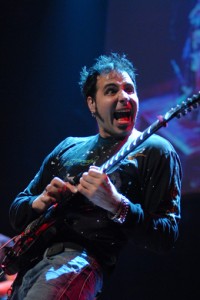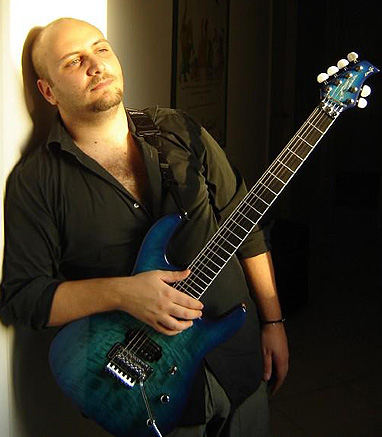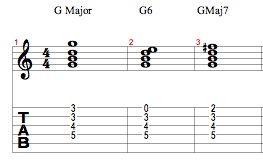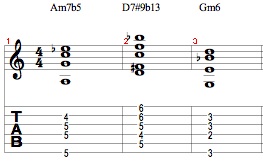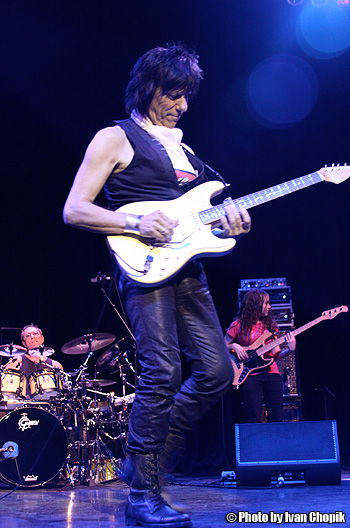 Visits from Jeff Beck are cause for celebration – not only because these visits are so infrequent, or even because Beck was one of three noted guitarists to emerge from Britain’s legendary Yardbirds in the 60’s. Ever since he came into the public eye, Beck has been pushing the boundaries of rock guitar playing in general, and the limitations of the Strat in particular. Beck takes harmonic and whammy bar techniques that many players use as effects, and creates full, expressive melodic lines with them. He also controls his volume knob with authority, by using smooth swells on melodies along to expand their dynamic range. This, coupled with Beck’s preference for fingers over picks, gives Beck a command of his instrument that allows him tremendous room for expression.
Visits from Jeff Beck are cause for celebration – not only because these visits are so infrequent, or even because Beck was one of three noted guitarists to emerge from Britain’s legendary Yardbirds in the 60’s. Ever since he came into the public eye, Beck has been pushing the boundaries of rock guitar playing in general, and the limitations of the Strat in particular. Beck takes harmonic and whammy bar techniques that many players use as effects, and creates full, expressive melodic lines with them. He also controls his volume knob with authority, by using smooth swells on melodies along to expand their dynamic range. This, coupled with Beck’s preference for fingers over picks, gives Beck a command of his instrument that allows him tremendous room for expression.
The musical context that surrounds his playing has changed with the times – hard rock in the 60’s, funky fusion in the 70’s, synthesized dance music in the 80’s and loop-based techno in the 90’s into the new millennium – but Beck’s basic style has not changed as much as it has evolved. While other players have surpassed Beck in speed, few can match his dynamic control and sheer range of expressive techniques. Beck has spent his time in the woodshed finding ways to create new sounds with his guitar, and create old sounds in new ways – and decades later he’s still at it. This year he was publicly recognized for his achievements by being inducted into the Rock and Roll Hall of Fame as a solo artist. Beck had been inducted before as a member of The Yarbirds in 1992, but now the world has officially given Beck credit for the unique and innovate style his fans have long appreciated.
When Jeff Beck walked onto the stage a few minutes after 8:45 at Boston’s new House Of Blues, he had the audience’s full attention without playing a single note. The main room of the House Of Blues was filled to capacity, having sold out weeks in advance. Many in the crowd were of the age to have grown up with Beck’s music, but many of them brought children with them, and a respectable piece of the audience consisted of young musicians eager for the opportunity to experience Beck’s legendary playing firsthand.
As soon as he burst into the triumphant ‘Beck’s Bolero,’ the older members of the crowd burst into enthusiastic cheers, recognizing the classic track from the Jeff Beck Group’s first album Truth. Beck’s stage presence was typically focused, but engaged – he gratefully acknowledged the roomful of fans, but kept most of his energy on performing his demanding lines. There were moments when Beck became visibly excited on stage, as he did during an explosive rendition of his live staple ‘Brush With The Blues.’ In recent years, Beck has been opening the song with part of his interpretation of the jazz standard ‘Goodbye Pork Pie Hat,’ so the audience knew what to expect when they heard the famous strains of Mingus’ melody. Beck built it slowly from a quiet blues, gradually increasing the volume and intensity of the song’s head until it reached the solo section, where he burst into passionate flailing that left his audience emotionally exhausted.
 Beck and his current band of Tal Wilkenfeld on bass, Jason Rebello on keys and Vinnie Colaiuta on drums laid the groove down hard on tracks like the reggae-inspired ‘Behind The Veil.’ Beck locked in with his band and delivered the song’s snappy and syncopated theme with energy to spare, and when it came time for the bridge’s soaring melody, his Strat positively screamed with barely controlled feedback. Although Beck often prefers to use his whammy bar for melodies that most would execute with a slide, he does break out a slide for key portions of his songs. ‘Angel (Footsteps)’ is played almost entirely with a slide, and Boston received an amazing rendition of this hypnotic melody. Beck’s intonation was spot on, and remained so even after the solo section, when he placed his slide above the frets entirely to play the refrain in a piercing octave. Against the song’s spacey backdrop, Beck’s liquid line was transcendent.
Beck and his current band of Tal Wilkenfeld on bass, Jason Rebello on keys and Vinnie Colaiuta on drums laid the groove down hard on tracks like the reggae-inspired ‘Behind The Veil.’ Beck locked in with his band and delivered the song’s snappy and syncopated theme with energy to spare, and when it came time for the bridge’s soaring melody, his Strat positively screamed with barely controlled feedback. Although Beck often prefers to use his whammy bar for melodies that most would execute with a slide, he does break out a slide for key portions of his songs. ‘Angel (Footsteps)’ is played almost entirely with a slide, and Boston received an amazing rendition of this hypnotic melody. Beck’s intonation was spot on, and remained so even after the solo section, when he placed his slide above the frets entirely to play the refrain in a piercing octave. Against the song’s spacey backdrop, Beck’s liquid line was transcendent.
The Nitin Sawhney composition ‘Nadia’ that Beck has been favoring in recent live sets had him interpreting the beautiful melody with volume swells and smooth dips of his whammy bar. Beck looked and sounded like he felt every note of the song, right up to its climax, when he gently rolled his volume up on one repeating, plaintive note. Beck had more trouble with the graceful ‘Where Were You.’ The brief ballad, with Beck playing rubato accompanied by Rebello’s soft synth pads, features one of Beck’s most challenging melodies. The tune itself is simple, but in addition to Beck’s usual and tasteful volume knob treatment, the melody involves an array of natural harmonics that Beck turns into melodies. To do this, he sounds the harmonic, and raises and depresses his whammy bar to the exact pitches of the melody. Sounding the harmonics and manipulating the bar to specific pitches are both challenging techniques, and smoothly fitting the dynamics of those unusual techniques into the melody is another task in itself. Beck struggled with some of the harmonics, and his pitches with the whammy bar were not always in tune, but nonetheless his performance was bold and earnest.
Since the late 90’s, Beck has been playing a lively instrumental arrangement of the Beatles’ ‘A Day In The Life,’ and his performance of it that night was one of the highlights of the show. The song gave Beck the opportunity to hit fierce and loud, and quickly break into a gentle, lilting melody – and he took amazing advantage of both extremes. Beck’s band was with him for every dynamic switch, helping him prove that a guitar in the right hands can be every bit as expressive as the human voice.












